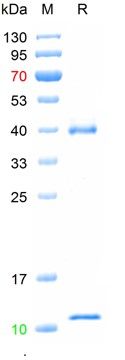Recombinant human HLA-C & Beta-2-MG Heterodimer protein, C-His (HEK293)
重组人重组织相容性复合体蛋白
| 英文名称 | Recombinant human HLA-C & Beta-2-MG Heterodimer protein, C-His (HEK293) |
| 中文名称 | 重组人重组织相容性复合体蛋白 |
| 别 名 | HLA-C; Major Histocompatibility Complex, Class I; HLA Class I Histocompatibility Antigen, C Alpha Chain; HLA-JY3; D6S204; PSORS1; HLAC; Major Histocompatibility Antigen HLA-C; MHC Class I Antigen Heavy Chain HLA-C; Human Leukocyte Antigen-C Alpha Chain; Psoriasis Susceptibility 1; Human Leukocyte Antigen C; HLA-C Antigen; HLA-Cw; HLC-C; MHC; HLAC_HUMAN; Recombinant human HLA-C / Beta-2-MG Heterodimer protein, C-His (HEK293) |
| 性 状 | Lyophilized or Liquid |
| 浓 度 | >0.5 mg/ml |
| 物 种 | Human |
| 序 列 | 25-305/366 (HLA-C) & 21-119/119 (Beta-2-MG) |
| 纯 度 | >90% as determined by SDS-PAGE |
| 纯化方法 | AC |
| 内毒素 | Not analyzed |
| 表达系统 | HEK293 cell |
| 活性 | Not tested |
| 标签 | C-His |
| 保存条件 | Stored at -70℃ or -20℃. Avoid repeated freeze/thaw cycles. |
| 注意事项 | This product as supplied is intended for research use only, not for use in human, therapeutic or diagnostic applications. |
| 产品介绍 | HLA-C belongs to the HLA class I heavy chain paralogues. This class I molecule is a heterodimer consisting of a heavy chain and a light chain (beta-2 microglobulin). The heavy chain is anchored in the membrane. Class I molecules play a central role in the immune system by presenting peptides derived from endoplasmic reticulum lumen. They are expressed in nearly all cells. The heavy chain is approximately 45 kDa and its gene contains 8 exons. Exon one encodes the leader peptide, exons 2 and 3 encode the alpha1 and alpha2 domain, which both bind the peptide, exon 4 encodes the alpha3 domain, exon 5 encodes the transmembrane region, and exons 6 and 7 encode the cytoplasmic tail. Polymorphisms within exon 2 and exon 3 are responsible for the peptide binding specificity of each class one molecule. Typing for these polymorphisms is routinely done for bone marrow and kidney transplantation. About 6000 HLA-C alleles have been described. The HLA system plays an important role in the occurrence and outcome of infectious diseases, including those caused by the malaria parasite, the human immunodeficiency virus (HIV), and the severe acute respiratory syndrome coronavirus (SARS-CoV). The structural spike and the nucleocapsid proteins of the novel coronavirus SARS-CoV-2, which causes coronavirus disease 2019 (COVID-19), are reported to contain multiple Class I epitopes with predicted HLA restrictions. Individual HLA genetic variation may help explain different immune responses to a virus across a population.[provided by RefSeq, Aug 2020] |
| 产品图片 |
本产品仅供科研使用.请勿用于医药,不能用于临床治疗诊断使用!

